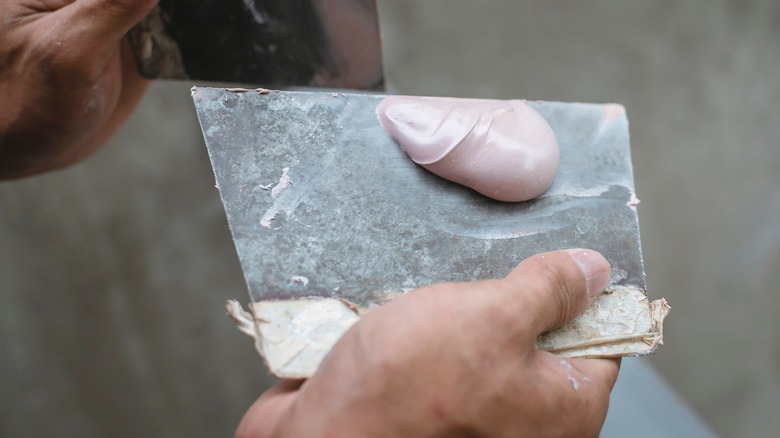The Fastest Fix For A Damaged Bathtub
Spotting a crack, chip, or hole in your bathtub is enough to send many homeowners into a panic. A major professional repair job or even tub replacement seems certain, with the inevitable blow to your bank account. Fortunately, a reasonably priced repair is actually as close as your nearest hardware store. Replacing a damaged bathtub could cost in excess of $3,000, according to Miracle Method Surface Refinishing, and other professional repairs can be considerably more costly than a home fix. A DIY repair kit containing waterproof tape, resins, and fillers, along with injectable foam and fiberglass mesh, is an inexpensive, readily available alternative. Along with these basic necessities for fixing the tub yourself, simple tools and rudimentary skills are all that is needed for a fast and economical repair.
Modern tubs tend to be made of synthetics such as fiberglass, acrylics, and plastic, with fiberglass being the most common. They can be damaged by any number of causes — heavy use, subpar materials, sharp objects, abrasive cleaners, or typical wear and tear. Insufficient support underneath a tub can also lead to problems. A small crack, gouge, or chip should be repaired as soon as possible, as flaws tend to worsen over time, and a damaged tub may eventually be rendered unusable, per Surface Doctors.
DIY fix for cracks, holes, and chips
There are several fundamental steps to follow for successful home repair. First, determine whether the damage is a crack, a chip, or an actual hole. There are different types of repair kits, so make sure you purchase the correct one for your needs. There are fiberglass kits available, as well as ones specifically designed for acrylic or porcelain surfaces. You will also need sandpaper, a drill, and safety wear.
Cracks in fiberglass tubs are often unavoidable, according to Badeloft. A heavy object dropped on the surface is capable of causing a stress crack. Hairline cracks, the result of constant use, are another common problem. These and other defects can all be addressed with the proper materials and some basic instructions. Waterproof tape or paint can be used to seal a surface crack, a process that is effective but not aesthetic. Deeper ones will need to be plugged with glue or paste.
Before attempting any repairs, it is important to thoroughly clean the surface using a gentle cleanser. Acetone or alcohol are effective for treating and removing stubborn bathtub scum or oil, explains American Home Shield.
Bathtub repair steps
Fill the crack with the resin or putty by smearing it directly over the flaw or applying it on top of fiberglass mesh, according to A-1 Tub & Tile Refinishers. These substances and the piece of netting will keep the tub watertight. Fill in all the crevices and don't fret about any excess filler as it will be sanded down once dry. However, take care not to use sandpaper beyond the crack, as you might have to repair that area as well.
Badeloft instructs wiping the dried area with alcohol to prepare it for bathtub repair paint, or a colorant from the repair kit. A layer of urethane can be the finishing touch to a professional-looking repair. If the repair seems wobbly or spongy, foam can be injected underneath it to remedy a substandard layer between the tub and the floor. It is advisable to wait at least two to three hours for any repair ingredients to cure and dry before using the tub.
A home repair job may not look as quite as pristine as a professional one, or not last as long, but, if the defect is relatively minor and you have the time, energy, and ability, repairing it yourself may be the way to go instead of going pro.


